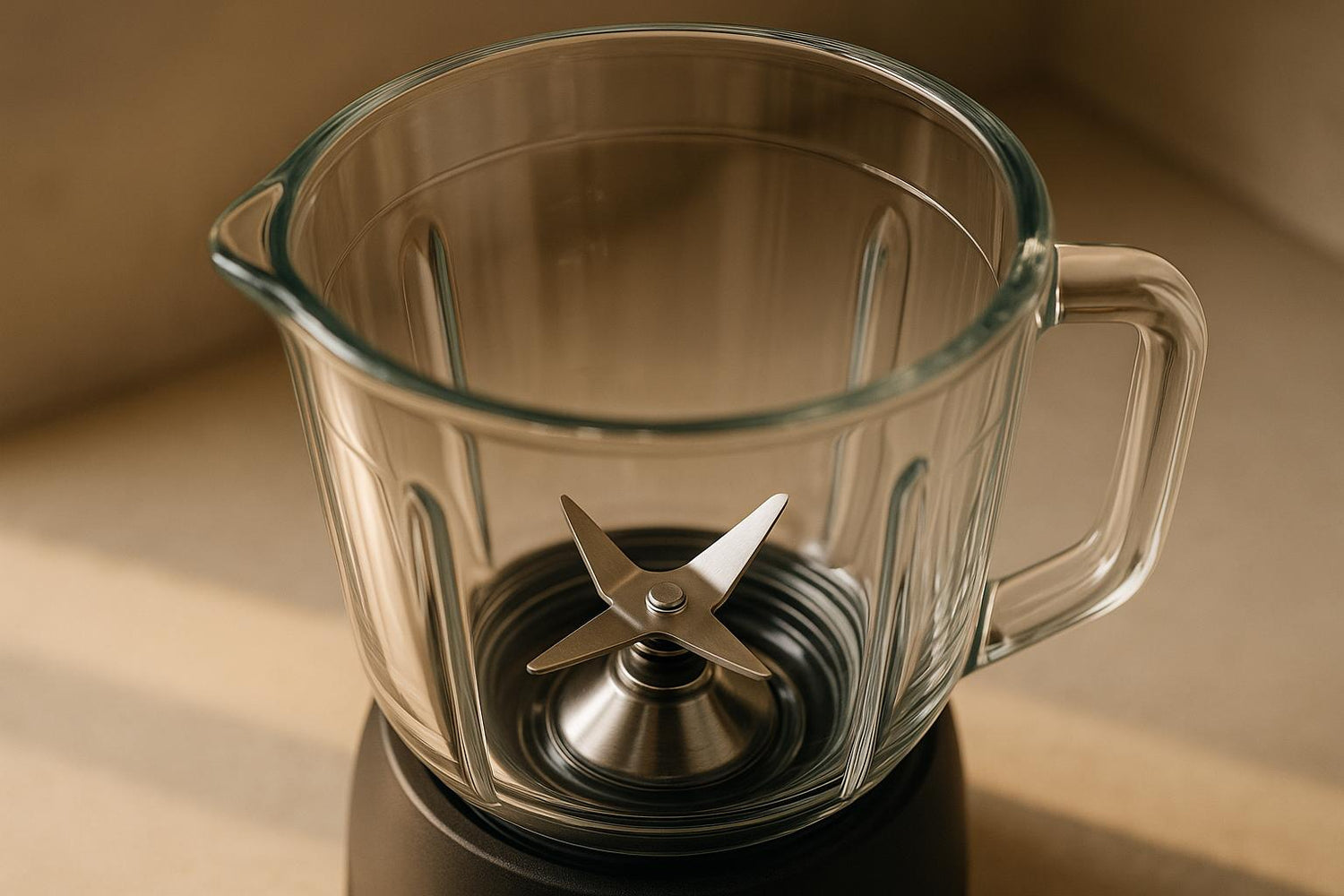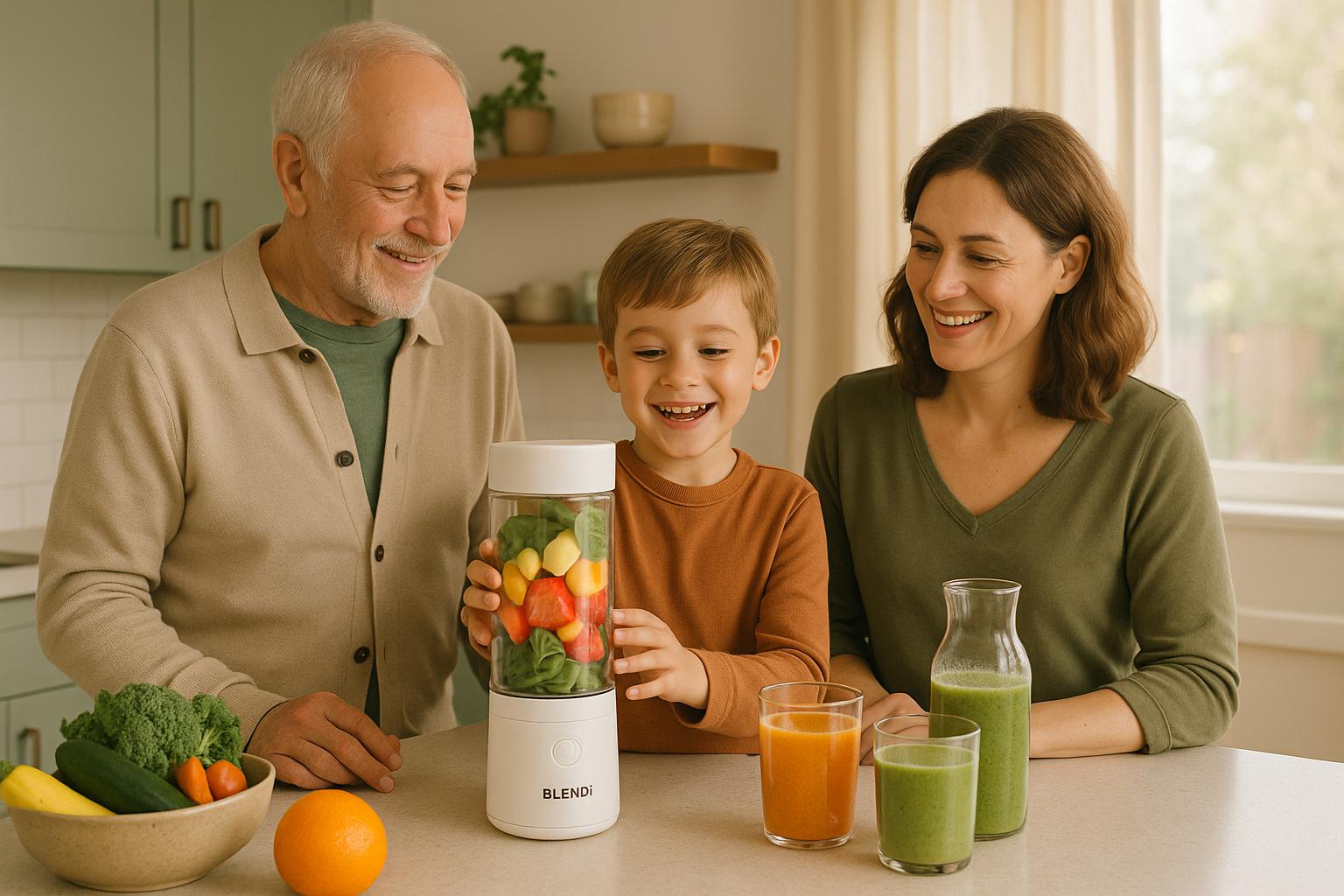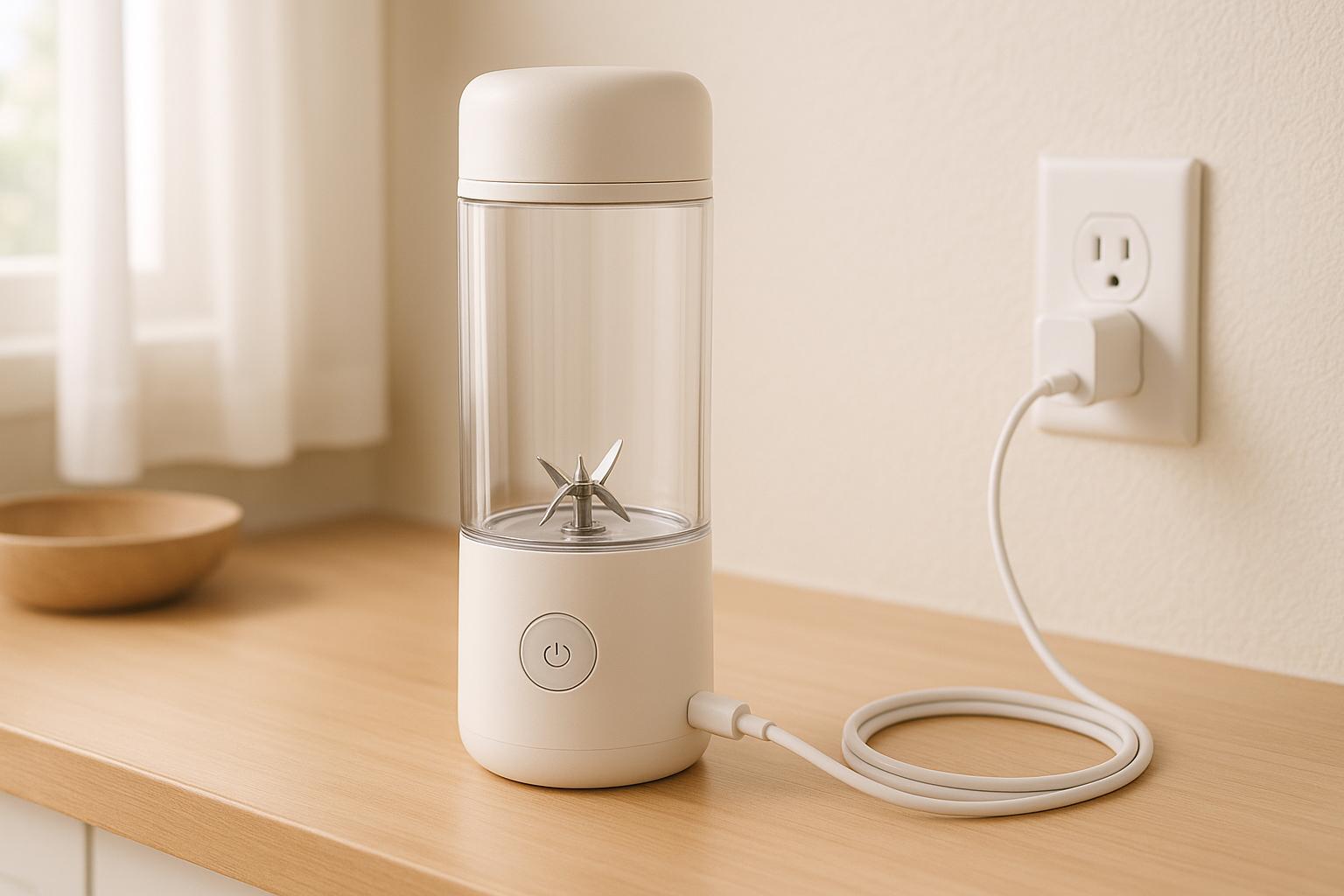Blender blades endure stress with every use, whether you're making smoothies, shakes, or crushing ice. Proper maintenance ensures they stay sharp, perform well, and last longer. Neglected blades can dull, damage motors, and even harbor bacteria. Here's the key to keeping them in top condition:
- Clean Regularly: Use the self-cleaning method for liquid blends or baking soda paste for stubborn residues. Always hand-wash portable blender blades to avoid damage.
- Dry Thoroughly: Prevent rust by drying blades immediately after cleaning. Avoid soaking or leaving them in dishwashers.
- Store Safely: Keep components dry and ventilated. For portable models, store with the lid off to prevent moisture buildup.
- Inspect Often: Look for dull edges, cracks, or buildup. Replace damaged parts promptly.
- Blend Smarter: Use the right settings and ingredient sizes to reduce strain on blades and motors.
How to Maintain Your Blender for Long Term Use | Blender Expert Tips and Tricks
How to Clean Blender Blades Step by Step
Keeping your blender blades clean is key to maintaining their sharpness and ensuring they work as they should. Regular cleaning prevents residue buildup, which can dull the blades and affect performance. The best cleaning method depends on what you've blended and how much residue is left behind.
Self-Cleaning Method
This is one of the easiest ways to clean your blender:
- Fill the blender jar halfway with warm water.
- Add 2-3 drops of dish soap.
- Secure the lid and blend on medium speed for about 15-20 seconds.
Once done, pour out the soapy water, rinse the jar thoroughly, and run the blender with plain water for another 10 seconds to remove any remaining soap. This method is particularly effective for liquid-based blends like smoothies and protein shakes.
Special Note for BLENDi Users: If you're using a BLENDi Portable blender, stick to hand cleaning only. Dishwashers can damage the electronic components due to heat and moisture. Remove the blade assembly, wash each part with warm, soapy water, and dry everything thoroughly before putting it back together.
If stubborn food particles remain after self-cleaning, move on to a more targeted cleaning method.
Removing Stubborn Residues
Sometimes, thicker or stickier blends - like those made with frozen fruits, nut butters, or protein powders - can leave behind tough residues that self-cleaning alone won’t handle. Here’s how to tackle them:
-
Use a Baking Soda Paste
Mix 2 tablespoons of baking soda with just enough water to create a thick paste. Apply the paste to the blade assembly and let it sit for 10-15 minutes. Baking soda naturally breaks down oils and proteins that may be stuck to the blades. -
Scrub with a Soft Brush
Take a soft-bristled toothbrush or bottle brush and gently scrub around the blade edges and base. Pay extra attention to areas where food tends to collect, like the blade joints and the jar's bottom. Avoid using steel wool or abrasive scrubbers, as they can scratch the stainless steel and create spots where bacteria might hide. -
Repeat if Necessary
If any residue remains, repeat the self-cleaning process using warm water to ensure everything is spotless.
Quick Tip for Protein Shake Lovers: Protein powder residues can harden fast, so clean your blender within 30 minutes of use. Once dried, protein powders become much harder to remove.
After cleaning, take a moment to inspect the blade assembly under good lighting. Look closely at the crevices where the blades meet the base to ensure no food particles are left behind. These hidden spots can trap bacteria and cause unpleasant odors if not cleaned properly.
How to Store and Handle Blender Blades
Taking care of your blender blades isn’t just about keeping them clean - it’s about ensuring they stay sharp, functional, and safe to use. How you dry, store, and handle these sharp components can make all the difference in their performance and longevity.
Drying and Preventing Moisture
Drying your blades thoroughly is non-negotiable. Moisture is a blade’s worst enemy, as it can lead to rust and corrosion, which can ruin both performance and durability.
After cleaning your blender, grab a clean towel and dry the blades immediately. Pay close attention to every surface, especially where the blades connect to the base assembly - these areas are prone to trapping moisture. Skipping this step could lead to long-term damage.
Never leave blender blades soaking in water for extended periods. This is especially true for dishwashers, as submerging the blade assembly can damage the seals that protect the internal bearings. If these seals fail, water can seep in, lubricant can leak out, and rust can take hold, all of which will degrade the blade’s performance.
For extra peace of mind, place the cleaned blade assembly on a clean kitchen towel and let it air dry for at least 30 minutes before putting it back together. This ensures no hidden moisture remains trapped in the assembly.
Once your blades are completely dry, you’re ready to store them properly.
Storage Recommendations
How you store your blender matters just as much as how you clean it. Proper storage can prevent moisture issues and extend the life of your blades.
If you’re using a BLENDi Portable blender, always store it with the lid off. This allows air to circulate inside the jar, preventing moisture buildup that could lead to odors or even mold.
Keep your blender in a cool, dry cabinet that’s well-ventilated and away from heat or humidity. Ensure every part of the blender, especially the blades, is completely dry before putting it away. These simple steps go a long way in keeping your blender in top shape.
Now that drying and storage are covered, let’s talk about handling your blades safely.
Safe Handling Practices
Blender blades are sharp - really sharp. Handling them correctly is essential for your safety and to avoid damaging the blades themselves.
Unplug your blender before doing any maintenance. Whether you’re cleaning, removing the blades, or inspecting them, make sure the blender is completely powered off. This applies to portable models too - always turn them off completely before taking them apart.
When removing the blades, take your time. Unscrew the blade assembly from the jar carefully, remove the rubber gasket, and then take out the blade. Keep your fingers far from the cutting edges to avoid injury.
Whenever possible, use tools instead of your bare hands. A handled sponge or a soft cloth gives you better control while keeping your fingers safe. Never touch the sharp edges directly, and if a blade falls, resist the urge to catch it.
When reassembling, make sure everything is secure. Tighten the blade assembly properly, ensure the jar is firmly seated on the motor base, and place the rubber gasket on the correct side of the blade assembly. Refer to your BLENDi manual for guidance - incorrect placement can lead to leaks or reduced performance.
sbb-itb-75eb6cf
Maintenance Tips for Long Blade Life
Taking care of your blender blades involves more than just cleaning and storing them properly. It’s about staying vigilant, adopting smart blending habits, and making adjustments to prevent unnecessary wear. These steps will ensure your blender continues to perform at its best for years.
Checking Blade Condition
Inspecting your blades regularly is key to keeping them in top shape. Make it a habit to check them monthly for signs of wear, like chips, cracks, or bent edges. Dull blades can make blending less efficient, leading to longer processing times and putting extra strain on your blender’s motor.
Pay attention to how your blender performs during use. If you notice it’s taking longer to achieve smooth textures or if chunks of ingredients remain unblended, it could be a sign that your blades are losing their sharpness. Additionally, unusual vibrations or strange noises during blending are red flags that require immediate attention.
Check the blade surfaces for buildup or discoloration, as residue can affect performance and may even harbor bacteria. To protect your blades, avoid exposing them to hard objects that could cause chips or dull their edges.
Avoiding Damage from Hard Objects
Protecting your blades from damage starts with knowing what not to blend. Avoid putting non-food items or overly hard objects into your blender. This includes oversized ice cubes, large chunks of frozen fruit, or any utensils accidentally dropped into the jar. Even high-performance blenders, like those in the BLENDi range, have limits to what they can safely handle.
To minimize strain on the blades, cut frozen fruits into smaller, 1-inch pieces before blending [13, 15, 16]. When layering ingredients, start with liquids, add softer items next, and save harder ingredients for the top. This order helps reduce stress on the blades and ensures smoother blending [13, 15, 17, 18].
For tougher ingredients, use the pulse function. Pulsing in short bursts of 3–5 seconds helps break down larger pieces before switching to continuous blending [15, 17]. Also, make sure to add enough liquid to keep the ingredients moving around the blades. A good starting ratio is 1 part liquid to 2 parts fruit, which helps prevent cavitation and reduces friction that could dull the blades over time.
By following these precautions, you’ll not only extend the life of your blades but also reduce wear on your blender’s motor.
Maintaining Blade Assembly and Seals
In addition to inspecting your blades, it’s important to take care of the seals and gaskets in your blade assembly. These components play a crucial role in preventing leaks and protecting the internal bearings from moisture, which can lead to rust and reduced performance.
Check seals regularly for cracks, tears, or other signs of wear. If you spot any damage, replace them immediately to avoid water seeping into the blade bearings. Refer to your BLENDi manual for the correct replacement parts and instructions.
To keep seals intact, avoid submerging the entire blade assembly in water, as this can damage internal lubricants. When reassembling your blender, ensure the rubber gasket is correctly positioned on the blade assembly. A misaligned gasket can lead to leaks and put extra stress on the motor, which can ultimately affect blade performance. The gasket should form a tight, secure seal between the blade assembly and the jar.
When tightening the blade assembly, aim for a snug fit - tight enough to prevent leaks but not so tight that it damages the threads or compresses the seals excessively. If you’re unsure about the correct level of tightness, consult your BLENDi user manual for specific guidance.
Fixing Common Blade Problems
Even with regular cleaning and upkeep, occasional blade issues can still crop up. Knowing how to handle these common problems can save you from expensive repairs or replacements. The good news? Most blade-related troubles have straightforward fixes you can manage at home.
Poor Blending Performance
If your blender starts leaving chunks behind or struggles to create smooth textures, the likely culprits are dull blades or residue buildup. Over time, blades can lose their sharpness, and leftover food particles can accumulate, both of which impact performance.
Make it a habit to inspect your blades during routine maintenance. Look for signs of wear or buildup. If cleaning doesn’t improve blending results, try soaking the blades in warm, soapy water to loosen stubborn residue. If that doesn’t work, it might be time to replace the blades.
Also, double-check your liquid-to-ingredient ratios. Using too little liquid can make blending harder. For BLENDi portable blenders, ensure you’re selecting the right blending mode for your ingredients. Each setting is designed to adjust blade speed and pulsing for specific textures.
Strange Noises or Stuck Blades
Odd sounds like grinding, squealing, or rattling during blending often mean something is interfering with the blades. When this happens, unplug the blender and remove the jar to investigate.
Start by looking for foreign objects in the blending chamber. It’s surprisingly easy for small items like bottle caps, utensil fragments, or large seeds to get lodged between the blades and jar walls.
Next, check the blade assembly for loose components. Over time, parts can loosen, causing wobbling or grinding noises. Tighten the assembly as outlined in your BLENDi manual, but be careful not to overtighten, as this could damage the threads or seals.
If you hear squealing or grinding, especially when the blender is running empty or at low speeds, it could point to worn bearings. Bearings can wear out or become contaminated with moisture over time. If cleaning and tightening don’t resolve the issue, you may need professional servicing or a blade assembly replacement.
Sometimes, blades that seem stuck are actually seized by dried food residue. Soak the jar in warm water for about 30 minutes to loosen the residue, then try rotating the blades manually (always with the blender unplugged).
If these steps don’t solve the problem, reach out to BLENDi customer support. Many blade issues are covered under warranty, but attempting complex repairs yourself could void your coverage. Keep your purchase receipt and model details handy when contacting support. By addressing these issues promptly, you’ll extend your blender’s lifespan and keep it running smoothly.
Key Points for Blade Maintenance
Keeping your BLENDi portable blender in top shape boils down to three essential habits: consistent cleaning, smart storage, and regular monitoring. Stick to these basics, and your blender will deliver reliable performance for years.
Start by cleaning your blender right after each use. Whether you use the self-cleaning function or wash it by hand, make sure to dry every part thoroughly before storing it. Moisture can lead to damage, so aim to store the components separately in a dry, ventilated space whenever possible.
Handle the blades carefully during cleaning and assembly. The sharp edges can easily get damaged if dropped or hit against hard surfaces. When reassembling, tighten the blade assembly securely, but avoid overtightening, as this can harm the threads or seals.
Make it a habit to check the blade's condition regularly. Look for signs like dull edges, chips, or loose components during your cleaning routine. If you notice your blender isn’t blending as smoothly, hear unusual noises, or see visible wear, address these issues promptly.
Also, be mindful of your BLENDi model's capabilities when selecting ingredients. For example:
- The Lite (70W) is ideal for soft fruits and liquids.
- The Pro+ (120W) and X (150W) models can handle tougher tasks like crushing ice.
Using the right ingredients and settings not only ensures better blending results but also minimizes unnecessary strain on the blades.
Finally, keep your warranty information handy. BLENDi offers a 1-year warranty covering many blade-related issues. However, attempting repairs on your own could void the warranty, so it’s best to reach out to customer support if you’re unsure how to fix a problem.
FAQs
How do I know if my blender blades are dull and need to be replaced?
If your blender blades have become dull, you might notice they struggle to blend ingredients properly, leaving you with uneven textures or making it harder to achieve the consistency you want. Here’s a quick test: gently run your fingernail along the blade’s edge. If it glides over without catching, it’s a sign the blade has lost its sharpness.
Dull blades not only impact blending performance but can also put extra strain on your blender. Replacing them as needed helps keep your blender running smoothly and ensures you get the best results. For portable options like BLENDi blenders, sharp blades are key to consistently crushing ice or whipping up smoothies wherever you are.
How can I prevent my blender blades from rusting?
To keep your blender blades in good condition and rust-free, make sure to dry them completely right after washing. Even though the blades are made of stainless steel, prolonged exposure to moisture can still lead to rust.
For extra care, store the blades in a dry place and apply a light coating of food-safe oil - such as mineral or coconut oil. This thin layer acts as a shield against moisture, helping to protect the blades from rust over time.
Why should I store my BLENDi Portable Blender with the lid off to prevent moisture buildup?
Properly storing your BLENDi Portable Blender is key to maintaining its cleanliness and hygiene. Always store it with the lid off to allow air to circulate. This helps prevent moisture from getting trapped inside, which can lead to mold, unpleasant odors, and bacteria buildup.
After cleaning or blending anything moist, leaving the lid off lets any leftover moisture evaporate naturally. This simple habit keeps your blender fresh, odor-free, and ready to perform at its best the next time you use it!




Leave a comment
This site is protected by hCaptcha and the hCaptcha Privacy Policy and Terms of Service apply.